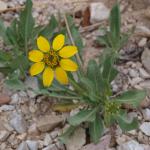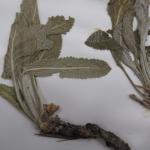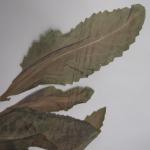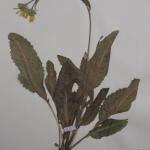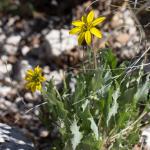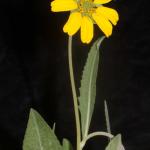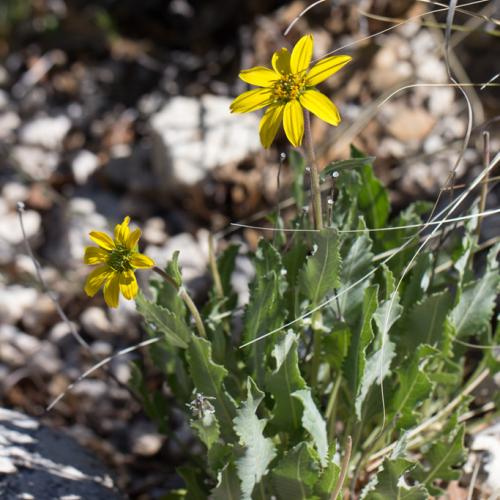Berlandiera macvaughii
None
| USFWS | State of NM | USFS | BLM | Navajo Nation | State Rank | Global Rank | R-E-D Code | NMRPTC Status | Strategy Status |
|---|---|---|---|---|---|---|---|---|---|
| S1 | G1Q | R | SS |
| Actions Needed |
|---|
More field searches and collections are needed in NM to establish the distribution and population sizes of B. macvaughii. |
Perennial herbs, 15-35 cm high, the stems arising from enlarged woody or lignescent roots. Leaves mostly basal, 10-18 cm long, 1.5-4.0 cm wide, petioles 2-7 cm long, blades ovate to linear-oblanceolate, passing into the petioles, scarcely lobed, of at all, the stem leaves mostly absent (except in occasional hybrids with B. lyrata), pinnately veined, pubescent on both faces, with mostly crenulate margins; heads 3-5 cm diam. including extended rays; peduncles 5-30 cm long, each with 1 or 2 (3) heads, hairy with numerous red to black warty hairs or red to black bulbous bases of hairs; involucre in 4-5 series, all similar in size and shape, the inner series falling with the achenes, broadly ovate, 10-15 mm long and as wide, apices broadly acute to narrowly obtuse; pales linear-oblanceolate, 5-8 mm long, 1-2 mm wide, apices rounded; ray florets 8, fertile, ligules 10-15 mm long, 3-5 mm wide, yellow on both surfaces, lower surfaces with 8 or more weakly defined veins, apices with sometimes 3 lobes; achenes broadly ovate to cordate, 5-6 mm long, 3-5 mm wide, epappose; disc florets staminate, numerous, corollas yellow, 4-5 mm long, lobes ca 0.5 mm long and pubescent. Flowering April through September.
The common chocolate flower, Berlandiera lyrata var. purpurea, has dark (red to maroon) disc florets (i.e., not yellow as in B. macvaughii) and the leaves are often cauline and lyrate to pinnatifid, while those of B. macvaughii are mostly basal, ovate to linear-oblanceolate with crenulate margins and neither lyrate nor pinnatifid. Berlandiera texana also has entire, ovate leaves, but its leaves are all cauline and its disc flowers are purple. The allopatric Berlandiera monocephala is very similar to B. macvaughii, occurs in Mexico and extreme southern AZ in a wider variety of habitats, but the peduncles lack the reddish to black warty hairs or reddish to black bulbous bases of hairs, a feature characteristic of both B. lyrata var. purpurea and B.macvaughii.
New Mexico, Eddy County, Guadalupe Mountains; Texas, Culberson County, Guadalupe Mountains, Pecos County, Sierra Madera, Brewster County, Glass Mountains.
Limestone rock outcrops and soils derived from limestone in mountainous terrain at elevations between 5,150 to 7,648 ft.
Berlandiera macvaughii is apparently common in the Guadalupe Mountains (Turner 2014).
There is apparent hybridization between B. lyrata and B. macvaughii. Numerous B. lyrata specimens are common in disturbed areas and on the bajadas at the base of the mountains in the Guadalupe Mountains of Texas (SEINet 2022). Therefore, hybridization between the two species is likely and some specimens exhibit the expected hybrid features.
The primary distribution of B. macvaughii is concentrated in the Guadalupe Mountains, in TX in the Guadalupe Mountains N.P. and in NM on BLM and private lands and possibly on Lincoln NF lands (Guadalupe RD).
Lowrey, T. 2020. Asteraceae. In: Allred, K.W., E.M. Jercinovic, and R.D. Ivey. Flora Neomexicana III: An Illustrated Identification Manual, Part 2: Dicotyledonous Plants: 106. Published by the authors at lulu.com.
Pinkava, D.J. 2006. Berlandiera: 83-87. In: Flora of North America Volume 21: Magnoliophyta: Asteridae (in part): Asteraceae, part 3. Flora of North America Association, Oxford University Press, New York.
SEINet. 2022. http//:swbiodiversity.org/index.php. Accessed on January 19, 2022.
*Turner, B.L. 2014. Texas taxa of the genus Berlandiera (Asteraceae: Heliantheae). Phytologia 96(4): 235-240.
For distribution maps and more information, visit Natural Heritage New Mexico

